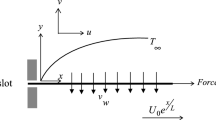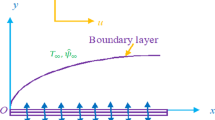Abstract
A theoretical study of mixed convection stagnation point flow towards a stretching surface is presented. The governing boundary layer equations are transformed into a set of highly nonlinear ordinary differential equations using suitable similarity transforms. The semi-analytical solution is obtained using optimal homotopy analysis method (OHAM) and the numerical solution is obtained via finite element method (FEM). Solutions obtained via two different approaches are in excellent agreement, which validates the accuracy of present analysis. In a special case, the present OHAM solution is also validated with the earlier available results. Effect of pertinent flow parameters on the skin friction coefficient and Nusselt number is presented in tabular form, whereas the velocity, temperature and nanoparticle distribution are presented in graphical forms. Further, a quadratic multiple regression analysis on numeric data of skin friction coefficient and Nusselt number is performed. The findings suggest that velocity slip assists the fluid motion in presence of buoyancy forces, whereas it exhibits a retarding nature on fluid motion when no buoyancy forces exist.













Similar content being viewed by others
References
Bhatti MM, Zeeshan A, Ellahi R (2017) Simultaneous effects of coagulation and variable magnetic field on peristaltically induced motion of jeffrey nanofluid containing gyrotactic microorganism. Microvasc Res 110:32–42
Buongiorno J (2006) Convective transport in nanofluids. J Heat Transf 128(3):240–250
BVPh2.0 software package (2017). http://numericaltank.sjtu.edu.cn/BVPh2_0.htm. Accessed 20 Jan 2017
Chamkha AJ, Jena SK, Mahapatra SK (2015) MHD convection of nanofluids: a review. J Nanofluids 4(3):271–292
Choi SUS (1995) Enhancing thermal conductivity of fluids with nanoparticles. ASME-Publ Fed 231:99–106
Crane LJ (1970) Flow past a stretching plate. Zeitschrift für Angewandte Mathematik und Physik ZAMP 21(4):645–647
Das SK, Choi SUS, Yu W, Pradeep T (2007) Nanofluids: science and technology. Wiley, New Jersey
Davidson PA (2001) An introduction to magnetohydrodynamics, vol 25. Cambridge University Press, Cambridge
Ellahi R, Tariq MH, Hassan M, Vafai K (2017) On boundary layer nano-ferroliquid flow under the influence of low oscillating stretchable rotating disk. J Mol Liquids 229:339–345
Esfahani JA, Akbarzadeh M, Rashidi S, Rosen MA, Ellahi R (2017) Influences of wavy wall and nanoparticles on entropy generation over heat exchanger plate. Int J Heat Mass Transf 109:1162–1171
Halim NA, Haq RU, Noor NFM (2017) Active and passive controls of nanoparticles in maxwell stagnation point flow over a slipped stretched surface. Meccanica 52(7):1527–1539
Hassan M, Zeeshan A, Majeed A, Ellahi R (2017) Particle shape effects on ferrofuids flow and heat transfer under influence of low oscillating magnetic field. J Magn Magn Mater 443:36–44
Hayat T, Sajjad R, Muhammad T, Alsaedi A, Ellahi R (2017) On MHD nonlinear stretching flow of powell-eyring nanomaterial. Results Phys 7:535–543
Hayat T, Sajjad R, Alsaedi A, Muhammad T, Ellahi R (2017) On squeezed flow of couple stress nanofluid between two parallel plates. Res Phys 7:553–561
Ibrahim W, Makinde OD (2016) Magnetohydrodynamic stagnation point flow of a power-law nanofluid towards a convectively heated stretching sheet with slip. Proc Inst Mech Eng Part E J Proc Mech Eng 230(5):345–354
Ishfaq N, Khan ZH, Khan WA, Culham RJ (2016) Estimation of boundary-layer flow of a nanofluid past a stretching sheet: a revised model. J Hydrodyn Ser B 28(4):596–602
Kakaç S, Pramuanjaroenkij A (2009) Review of convective heat transfer enhancement with nanofluids. Int J Heat Mass Transf 52(13):3187–3196
Kandasamy R, Loganathan P, Arasu PP (2011) Scaling group transformation for MHD boundary-layer flow of a nanofluid past a vertical stretching surface in the presence of suction/injection. Nuclear Eng Des 241(6):2053–2059
Khan WA, Pop I (2010) Boundary-layer flow of a nanofluid past a stretching sheet. Int J Heat Mass Transf 53(11):2477–2483
Khan WA, Makinde OD, Khan ZH (2016) Non-aligned MHD stagnation point flow of variable viscosity nanofluids past a stretching sheet with radiative heat. Int J Heat Mass Transf 96:525–534
Khanafer K, Vafai K, Lightstone M (2003) Buoyancy-driven heat transfer enhancement in a two-dimensional enclosure utilizing nanofluids. Int J Heat Mass Transf 46(19):3639–3653
Kuznetsov AV, Nield DA (2013) The cheng-minkowycz problem for natural convective boundary layer flow in a porous medium saturated by a nanofluid: a revised model. Int J Heat Mass Transf 65:682–685
Kuznetsov AV, Nield DA (2014) Natural convective boundary-layer flow of a nanofluid past a vertical plate: a revised model. Int J Therm Sci 77:126–129
Liao SJ (1992) The proposed homotopy analysis technique for the solution of nonlinear problems. PhD thesis, Shanghai Jiao Tong University
Liao S (2010) An optimal homotopy-analysis approach for strongly nonlinear differential equations. Commun Nonlinear Sci Numer Simul 15(8):2003–2016
Makinde OD, Khan WA, Khan ZH (2017) Stagnation point flow of MHD chemically reacting nanofluid over a stretching convective surface with slip and radiative heat. Proc Inst Mech Eng Part E J Process Mech Eng 231(4):695–703
Makinde OD (2013) Effects of viscous dissipation and newtonian heating on boundary-layer flow of nanofluids over a flat plate. Int J Numer Methods Heat Fluid Flow 23(8):1291–1303
Makinde OD, Aziz A (2011) Boundary layer flow of a nanofluid past a stretching sheet with a convective boundary condition. Int J Thermal Sci 50(7):1326–1332
Makinde OD, Khan WA, Khan ZH (2013) Buoyancy effects on MHD stagnation point flow and heat transfer of a nanofluid past a convectively heated stretching/shrinking sheet. Int J Heat Mass Transf 62:526–533
Makinde OD, Khan WA, Culham JR (2016) MHD variable viscosity reacting flow over a convectively heated plate in a porous medium with thermophoresis and radiative heat transfer. Int J Heat Mass Transf 93:595–604
Masuda H, Ebata A, Teramae K (1993) Alteration of thermal conductivity and viscosity of liquid by dispersing ultra-fine particles. dispersion of Al2O3, SiO2 and TiO2 ultra-fine particles. Netsu Bussei 7(4):227–233
Nadeem S, Lee C (2012) Boundary layer flow of nanofluid over an exponentially stretching surface. Nanoscale Res Lett 7(1):94
Nield DA, Kuznetsov AV (2009) The cheng-minkowycz problem for natural convective boundary-layer flow in a porous medium saturated by a nanofluid. Int J Heat Mass Transf 52(25):5792–5795
Olanrewaju AM, Makinde OD (2013) On boundary layer stagnation point flow of a nanofluid over a permeable flat surface with newtonian heating. Chem Eng Commun 200(6):836–852
Pal D, Mandal G (2015) Mixed convection-radiation on stagnation-point flow of nanofluids over a stretching/shrinking sheet in a porous medium with heat generation and viscous dissipation. J Petrol Sci Eng 126:16–25
Pop I, Na T-Y (1996) Unsteady flow past a stretching sheet. Mech Res Commun 23(4):413–422
Rana P, Bhargava R (2012) Flow and heat transfer of a nanofluid over a nonlinearly stretching sheet: a numerical study. Commun Nonlinear Sci Numer Simul 17(1):212–226
Rashidi S, Esfahani JA, Ellahi R (2017) Convective heat transfer and particle motion in an obstructed duct with two side by side obstacles by means of DPM model. Appl Sci 7(4):431
Rashidi S, Akar S, Bovand M, Ellahi R (2018) Volume of fluid model to simulate the nanofluid flow and entropy generation in a single slope solar still. Renew Energy 115:400–410
Reddy JN, Gartling DK (2010) The finite element method in heat transfer and fluid dynamics. CRC Press, New York
Rehman KU, Khan AA, Malik MY, Makinde OD (2017) Thermophysical aspects of stagnation point magnetonanofluid flow yields by an inclined stretching cylindrical surface: a non-newtonian fluid model. J Braz Soc Mech Sci Eng 39:3669–3682
Seini IY, Makinde OD (2014) Boundary layer flow near stagnation-points on a vertical surface with slip in the presence of transverse magnetic field. Int J Num Methods Heat Fluid Flow 24(3):643–653
Seth GS, Mishra MK (2017) Analysis of transient flow of MHD nanofluid past a non-linear stretching sheet considering naviers slip boundary condition. Adv Powder Technol 28(2):375–384
Seth GS, Sharma R, Kumbhakar B, Chamkha AJ (2016) Hydromagnetic flow of heat absorbing and radiating fluid over exponentially stretching sheet with partial slip and viscous and joule dissipation. Eng Comput 33(3):907–925
Seth GS, Sharma R, Mishra MK, Chamkha AJ (2017) Analysis of hydromagnetic natural convection radiative flow of a viscoelastic nanofluid over a stretching sheet with soret and dufour effects. Eng Comput 34(2):603–628
Sheikholeslami M, Ganji DD (2016) External magnetic field effects on hydrothermal treatment of nanofluid: numerical and analytical studies. William Andrew, New York
Shirvan KM, Ellahi R, Mamourian M, Moghiman M (2017) Effects of wavy surface characteristics on natural convection heat transfer in a cosine corrugated square cavity filled with nanofluid. Int J Heat Mass Transf 107(Suppl C):1110–1118
Shirvan KM, Mamourian M, Mirzakhanlari S, Ellahi R (2017) Numerical investigation of heat exchanger effectiveness in a double pipe heat exchanger filled with nanofluid: a sensitivity analysis by response surface methodology. Powder Technol 313:99–111
Tripathi R, Seth GS, Mishra MK (2017) Double diffusive flow of a hydromagnetic nanofluid in a rotating channel with hall effect and viscous dissipation: active and passive control of nanoparticles. Adv Powder Technol 28(10):2630–2641
Author information
Authors and Affiliations
Corresponding author
Additional information
Communicated by Corina Giurgea.
Rights and permissions
About this article
Cite this article
Seth, G.S., Mishra, M.K. & Tripathi, R. Modeling and analysis of mixed convection stagnation point flow of nanofluid towards a stretching surface: OHAM and FEM approach. Comp. Appl. Math. 37, 4081–4103 (2018). https://doi.org/10.1007/s40314-017-0565-3
Received:
Revised:
Accepted:
Published:
Issue Date:
DOI: https://doi.org/10.1007/s40314-017-0565-3




